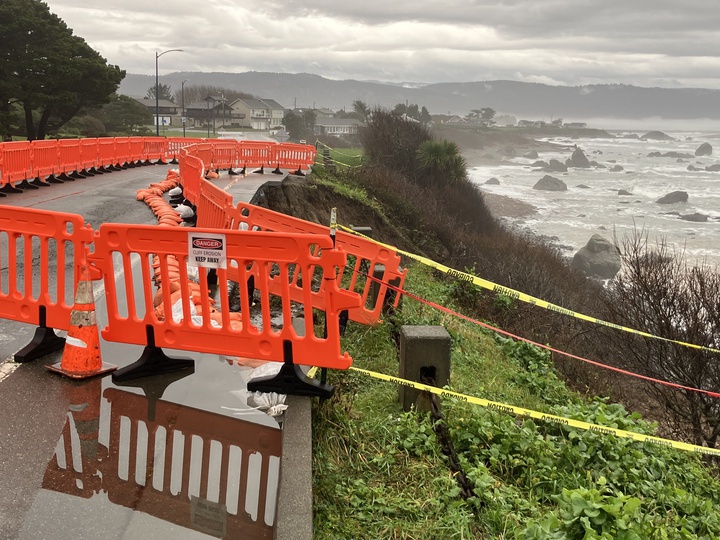Jessica Cejnar Andrews / Monday, July 8, 2024 @ 12:50 p.m. / Infrastructure, Local Government
Crescent City Gets State Emergency Proclamation For Pebble Beach Drive, Paving The Way For A Possible Fix

Crescent City got the state emergency proclamation it needed to move forward on reopening Pebble Beach Drive following a January landslide.
Previously:
• Though Emergency Dollars Appear Less Likely For Pebble Beach Drive, State May Still Offer a Solution
• Pebble Beach Landslide Highlights City's Funding, Permitting Dilemma For Long-Term Fix
###
Crescent City’s chances for receiving the state emergency dollars it needs to reopen Pebble Beach Drive have improved, even if it’s a bit late.
Noting that California Gov. Gavin Newsom on June 21 issued an emergency proclamation for Del Norte County, City Manager Eric Wier said staff will submit a damage assessment form for $6.6 million in emergency opening dollars to the Federal Highways Administration.
Crescent City will have until November to do the repairs that fixes damage from the January landslide, Wier told the Wild Rivers Outpost. Newsom’s emergency proclamation was tied to storms that occurred in March. In order for the city to be reimbursed, the project must be finished within nine months after the declared disaster occurred, Wier said.
“We weren’t really aware he was going to sign this or how it was going to work or what disaster we were going to be put on,” he said. “It was a surprise when I got the email and we were added to this disaster.”
Though Crescent City’s damage assessment form will be sent to the Federal Highways Administration, emergency opening dollars come from Caltrans and CalOES. At its July 15 meeting, the City Council will be ased to reissue an emergency proclamation, which will enable the city to hire contractors and design professionals.
The scenic drive between Seventh and Eighth streets has been closed to vehicles and pedestrians since Jan. 14. The Crescent City Council declared a local emergency at every meeting between Feb. 5 and May 6 and the California Coastal Commission toured the area during its meeting in Crescent City on May 9.
Though it appears Crescent City will receive emergency opening dollars for the immediate landslide repair, a cash flow dilemma persists. This dilemma affects the immediate repairs since that emergency funding will be reimbursed to Crescent City. It has also kept the city from moving forward on a larger project to shore up roughly 1,500 feet of coastline from Sixth Street to Preston Island.
On Wednesday, Wier told the Outpost that the city is working with State Sen. Mike McGuire’s office as well as Caltrans and CalOES to try to find a solution.
“It would almost have to be some sort of a bridge loan [using] state money to complete the project up front and then submit to Federal Highways for reimbursement, and that reimbursement money would go back to make the state whole,” Wier said.
The Pebble Beach Drive Bank Stabilization Project would address storm damage from December 2016 and is expected to cost $32 million. The Federal Highways Administration already authorized funding for the project through its Advanced Construction program.
But Crescent City would have to pay for the project up front and then seek reimbursement through Congress.
The FHA has approved funding for about 88.5 percent of the project. About 9 percent of the project cost would be reimbursed through Caltrans and CalOES. Crescent City would have to contribute 3 percent, roughly $1 million, toward the project cost, according to Wier.
“A $7 million or even a $30 million project, we can’t put up those kinds of funds,” he said.
According to Wier, there are two potential solutions to fix the damage from January. The most feasible is constructing a micropile wall, he said. That incorporates rebar drilled vertically and horizontally into the bank in an effort to create stability, he said.
A soldier pile wall is similar in methodology but involves drilling larger beams into the bedrock with more spacing and larger tiebacks into the soil itself, Wier said.
“That one’s more complicated and takes different machinery versus something like a micropile wall, which is dealing with a lot smaller structural pieces at a more frequent basis,” he said. “It’s easier to install and should be more cost-effective.”
CLICK TO MANAGE